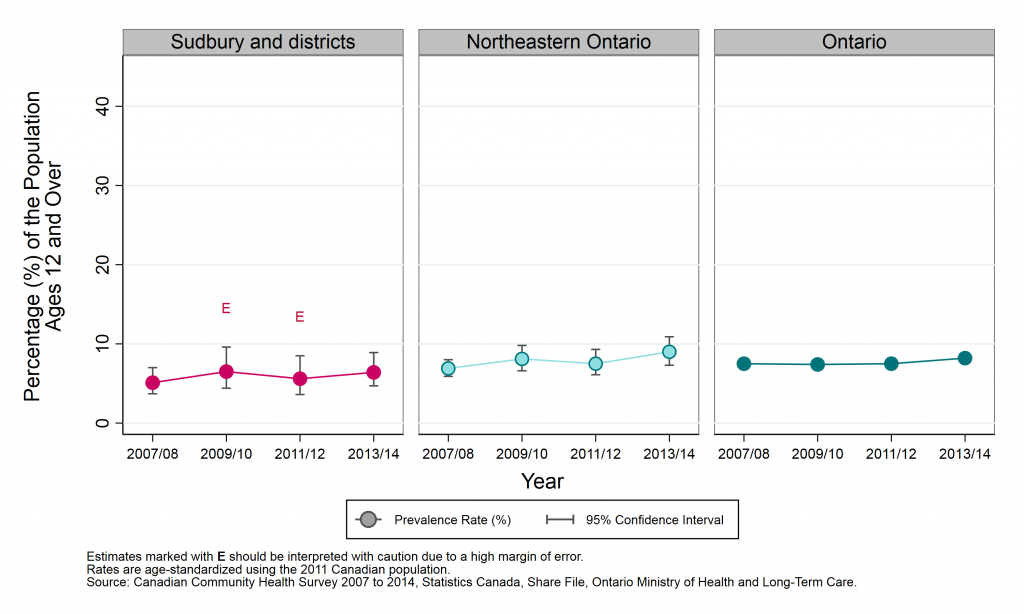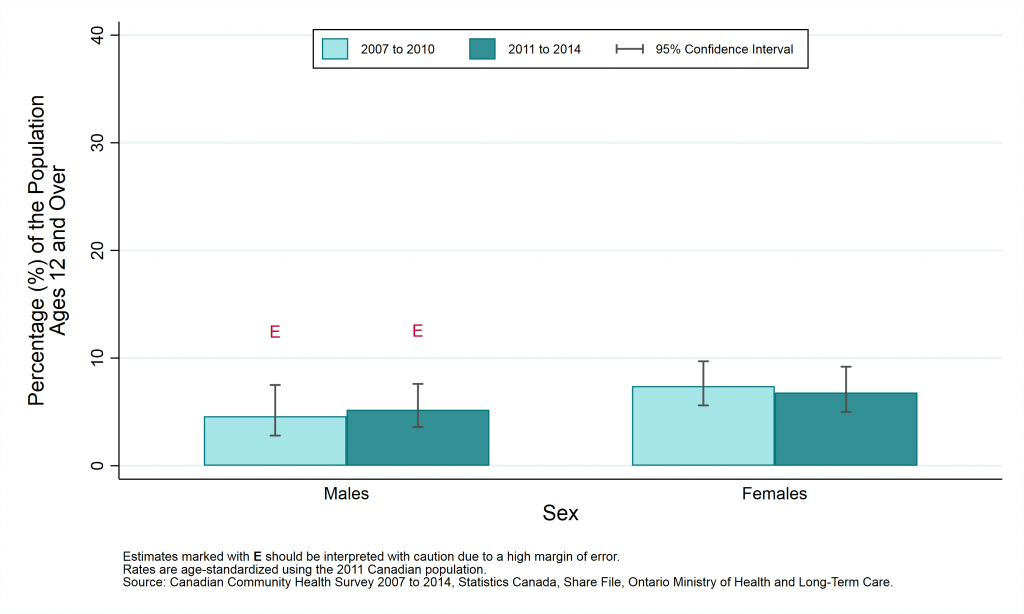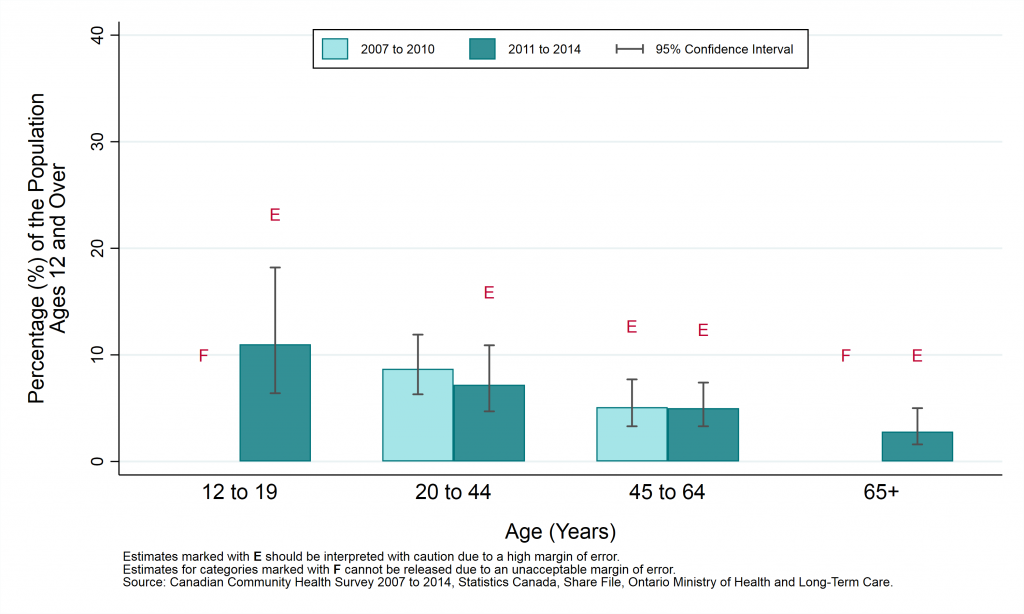Food insecurity
Food insecurity is inadequate or insecure access to food because of financial constraints1. Based on a set of 18 questions, a household’s food security status is categorized here as follows:
- Food secure: Little indication of difficulty with income-related food access.
- Moderately food insecure: Indication of compromise in quality and/or quantity of food consumed.
- Severely food insecure: Indication of reduced food intake and disrupted eating patterns.
We present rates of individuals aged 12 years and over living in households classified as moderately or severely food insecure within the past 12 months.
1Tarasuk, V, Mitchell, A, Dachner, N. (2016).Household food insecurity in Canada, 2014.Toronto: Research to identify policy options to reduce food insecurity (PROOF). Retrieved from http://proof.utoronto.ca
Food insecurity by geographic area
Key findings:
- In 2013/14, survey results indicated that 6% of the population aged 12 years and older in Sudbury and districts lived within a food insecure household.
- The prevalence rate of food insecurity has been similar to that reported in northeastern Ontario and Ontario overall.
- Between 2007/08 and 2013/14, the rate of food insecurity in Sudbury and districts has not varied significantly.
Notes:
- Rates are age-standardized using the 2011 Canadian population.
- Rates are for the population aged 12 years and older.
- Data source: Canadian Community Health Survey (CCHS), 2007 to 2014, Statistics Canada, Share File, Ontario Ministry of Health and Long-Term Care.
Figure: Age-standardized prevalence rate, food insecurity, by year and geographic area, ages 12+, 2007/08 to 2013/14

Table: Age-standardized prevalence rate, food insecurity, by year and geographic area, ages 12+, 2007/08 to 2013/14
Note: Numbers followed by the letter “E” are to be interpreted with caution due to high sampling variability.
| Geographic Region | Prevalence Rate, 2007 to 2008 | Prevalence Rate, 2009 to 2010 | Prevalence Rate, 2011 to 2012 | Prevalence Rate, 2013 to 2014 |
|---|---|---|---|---|
| Sudbury and districts | 5.1% (CI: 3.7% to 7.0%) | 6.5% E (CI: 4.4% to 9.6%) | 5.6% E (CI: 3.6% to 8.5%) | 6.4% (CI: 4.7% to 8.9%) |
| Northeastern Ontario | 6.9% (CI: 5.9% to 8.0%) | 8.1% (CI: 6.6% to 9.8%) | 7.5% (CI: 6.1% to 9.3%) | 9.0% (CI: 7.3% to 10.9%) |
| Ontario | 7.5% (CI: 7.0% to 8.1%) | 7.4% (CI: 7.0% to 7.9%) | 7.5% (CI: 7.0% to 8.1%) | 8.2% (CI: 7.7% to 8.8%) |
Food insecurity by sex
Key findings
- Between 2011 and 2014, survey results indicated that the rate of household food insecurity in Sudbury and districts did not vary significantly by sex.
- Between 2007 to 2010 and 2011 to 2014, the rate of food insecurity has not varied significantly in either males or females in Sudbury and districts.
Notes:
- Rates are age-standardized using the 2011 Canadian population.
- Rates are for the population aged 12 years and older.
- Data source: Canadian Community Health Survey (CCHS), 2007 to 2014, Statistics Canada, Share File, Ontario Ministry of Health and Long-Term Care.
Figure: Age-standardized prevalence rate, food insecurity, by year and sex, ages 12+, 2007 to 2010 and 2011 to 2014

Table: Age-standardized prevalence rate, food insecurity, by year and sex, ages 12+, 2007 to 2010 and 2011 to 2014
Note: Numbers followed by the letter “E” are to be interpreted with caution due to high sampling variability.
| Sex | Prevalence Rate, 2007 to 2010 | Prevalence Rate, 2011 to 2014 |
|---|---|---|
| Males | 4.6% E (CI: 2.8% to 7.5%) | 5.2% E (CI: 3.6% to 7.6%) |
| Females | 7.4% (CI: 5.6% to 9.7%) | 6.8% (CI: 5.0% to 9.2%) |
Food insecurity by age group
Key findings:
- Between 2011 and 2014, survey results indicated that the prevalence rate of household food insecurity in Sudbury and districts did not vary significantly by age group.
- Reported rates of food insecurity did not vary significantly between 2007 to 2010 and 2011 to 2014, though the trend could not be assessed in every age group.
Notes:
- Rates are age-standardized using the 2011 Canadian population.
- Data source: Canadian Community Health Survey (CCHS), 2007 to 2014, Statistics Canada, Share File, Ontario Ministry of Health and Long-Term Care.
Figure: Prevalence rate, food insecurity, by year and age group, ages 12+, 2007 to 2010 and 2011 to 2014

Table: Prevalence rate, food insecurity, by year and age group, ages 12+, 2007 to 2010 and 2011 to 2014
Note: Numbers followed by the letter “E” are to be interpreted with caution due to high sampling variability.
The letter “F” is to be interpreted as an estimate which has been suppressed due to high sampling variability.
| Age (Years) | Prevalence Rate, 2007 to 2010 | Prevalence Rate, 2011 to 2014 |
|---|---|---|
| 12 to 19 | F | 11.0% E (CI: 6.4% to 18.2%) |
| 20 to 44 | 8.7% (CI: 6.3% to 11.9%) | 7.2% E (CI: 4.7% to 10.9%) |
| 45 to 64 | 5.1% E (CI: 3.3% to 7.7%) | 5.0% E (CI: 3.3% to 7.4%) |
| 65+ | F | 2.8% E (CI: 1.6% to 5.0%) |
Food insecurity by household income
Key findings:
- There was insufficient data in the most recent time period to release reliable results for this indicator.
Food insecurity by education
Key findings:
- There was insufficient data in the most recent time period to release reliable results for this indicator.
This item was last modified on October 15, 2018
